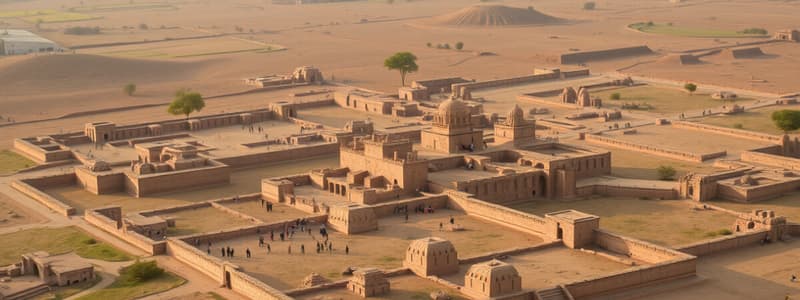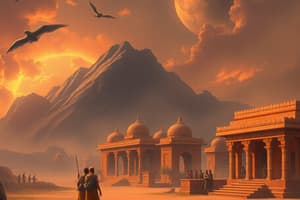Podcast
Questions and Answers
What was the Indus River Valley Civilization also known as?
What was the Indus River Valley Civilization also known as?
Harappan Civilization
In which period did the Mature Harappan phase occur?
In which period did the Mature Harappan phase occur?
- 1900–1300 BCE
- 3300–2600 BCE
- 7000–3000 BCE
- 2600–1900 BCE (correct)
The Late Harappan phase was characterized by the expansion of urban networks.
The Late Harappan phase was characterized by the expansion of urban networks.
False (B)
What major resources were traded by the Indus Valley Civilization?
What major resources were traded by the Indus Valley Civilization?
Which of the following materials were used for bead making?
Which of the following materials were used for bead making?
What type of figurines were commonly found in the Indus Valley artifacts?
What type of figurines were commonly found in the Indus Valley artifacts?
The first known use of ____ as a fiber for weaving textiles occurred in the Indus Valley.
The first known use of ____ as a fiber for weaving textiles occurred in the Indus Valley.
What was the purpose of seals discovered in the Indus Valley?
What was the purpose of seals discovered in the Indus Valley?
The Indus Valley Civilization had significant monumental architecture marking palaces and temples.
The Indus Valley Civilization had significant monumental architecture marking palaces and temples.
What is one theory for the collapse of the Harappan society?
What is one theory for the collapse of the Harappan society?
Study Notes
Indus Valley Civilization Overview
- Existed from 3300-1300 BCE, also known as the Harappan Civilization.
- Spanned modern-day northeast Afghanistan, Pakistan, and northwest India.
- First discovered in 1856 by a railroad crew, with key cities Mohenjo-Daro and Harappa.
Phases of the Indus Valley Civilization
-
Early Harappan (3300–2600 BCE):
- Featured intensive agriculture and large urban centers.
- Established extensive trade networks.
-
Mature Harappan (2600–1900 BCE):
- Notable settlements included Harappa, Ganeriwala, Mohenjo-Daro, and others across present-day Pakistan and India.
-
Late Harappan (1900–1300 BCE):
- Marked by urban network breakdown and rural expansion.
Roots and Development
- Roots trace back to about 7000 BCE with early herders transitioning to farming.
- Trading expanded via waterways, connecting to the Arabian Sea, Persian Gulf, and Mesopotamia.
Arts and Crafts
- Industries included pottery, dyeing, metalworking in bronze, and bead-making.
- Bead materials sourced from various regions: jade, lapis lazuli, turquoise, amethyst, and local steatite.
- Thousands of seals made of steatite and other materials, often depicting animals and serving commercial purposes or as identity cards.
Urban Planning and Architecture
- Flourished around 2500 BCE and lasted for approximately 500 years.
- Major cities like Harappa and Mohenjo-Daro were around three miles in circumference, with populations nearing 40,000.
- Features included a citadel, communal bath, granary, fortified walls, and a grid layout for streets.
- Each house typically had its own well, bathing area, and advanced drainage systems.
Burial Practices
- Burials often included simple grave goods such as food pots, jewelry, mirrors, and cosmetics.
- Contrasts with elaborate royal burials seen in Egypt and Mesopotamia.
Decline of the Indus Valley Civilization
-
Climate Change Theory:
- The drying of the Saraswati River around 1900 BCE is a potential cause of collapse, alongside theories of catastrophic flooding.
- Environmental shifts possibly led to crop failures, starvation, and disease outbreaks, including malaria, contributing to societal breakdown.
-
Economic and civic disorder arose in urban areas as a result of these changes.
Studying That Suits You
Use AI to generate personalized quizzes and flashcards to suit your learning preferences.
Related Documents
Description
Explore the fascinating history of the Indus Valley Civilization, also known as the Harappan Civilization, which flourished between 3300-1300 BCE. Discover its urban designs, major cities like Mohenjo-daro and Harappa, and the extent of its influence stretching from modern Afghanistan to India and Pakistan.




